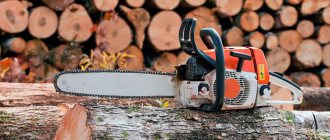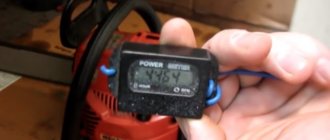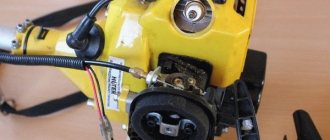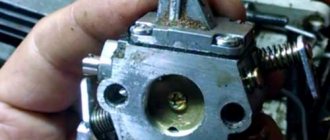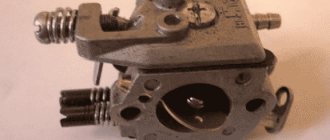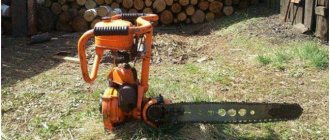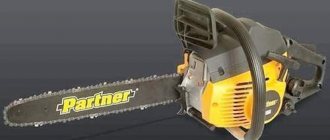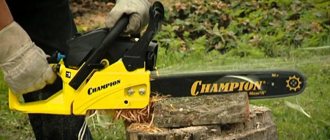Almost all power drives of chainsaw equipment produced in recent years are equipped with easy start and electronic ignition systems, decompressors and booster pumps. When asked why the chainsaw does not start with such rich equipment, service specialists do not give a definite answer.
Depending on the class and purpose, domestic and professional models are equipped with carburetor power units of a similar design, running on high-octane motor gasoline with a small admixture of motor oil for two-stroke engines.
The working volume of chainsaw engines varies from 26 to 60 cm3, power ranging from 1 to more than 6 hp. A characteristic feature of chainsaw drives is maximum compactness, convenient maintenance, and access to setting points. The standard service life of budget models is 1,500 hours, branded ones - more than 2,000.
Features of returning chainsaw scrap
It is not always possible to check a tool purchased in a store in operation, since even reputable trading organizations, citing the lack of conditions and fire regulations, reduce pre-sale preparation to a minimum.
- Each new model may differ in design from previous developments. Therefore, the owner of the tool begins to prepare for the first start by studying the instruction manual. The work is carried out in accordance with the manufacturer's recommendations.
- If the new tool has obvious damage, does not start or is not complete, it is advisable to return the chainsaw to the seller.
- The store is obliged to accept the defective product, exchange it for an identical model or return the money. Chainsaws that have obvious signs of disassembly or operational damage cannot be returned.
Defective new chainsaw, subject to exchange at the place of purchase within 14 days. After this time, the warranty comes into force, allowing you to fix the tool malfunction free of charge in a service center.
Why does a chainsaw start and immediately stall?
The chainsaw starts and immediately stalls; the reason for this behavior may be hidden in the carburetor. A malfunction of the fuel pump or a malfunction of the main fuel jet may cause this behavior of the saw. The inability of the chainsaw to operate after starting requires a full diagnosis at a service center.
All of the above options for engine malfunction have similar causes, which, depending on their neglect, can have different manifestations. For example, with a slight leak of air into the engine crankcase, its operation will not change much, the engine power will drop slightly, its maximum speed will increase, and it will be able to heat up a little more. At medium stages of air leakage, the engine will stop idling and will become very hot during operation. A strong air leak will make it impossible for the saw to operate; it will start and immediately stall.
Limitations in independently finishing the warranty instrument
Even with an easy start system, new, untested equipment is relatively difficult to start. It is not recommended to disassemble the recoil starter before the end of the warranty service and repair period.
- For service departments, such a modification may be a reason to refuse free replacement of failed, more valuable equipment.
- If you independently eliminate minor deficiencies, such as “gasoline does not flow” or “the air intake is loose,” penalties are not applied.
- Practice shows that problems with starting budget chainsaws appear after 2-3 years of operation. In such a situation, the owner has to put up with additional repair costs or rely on his own plumbing skills.
Thanks to the higher quality of materials and factory assembly, branded models have an order of magnitude fewer problems with starting. However, the recommendations given in this article may be useful for owners of mid- and high-end chainsaws.
The information received will prompt you in the direction of solving the problem when the Chinese chainsaw does not start. Almost all Chinese chainsaw imports are developed on the basis of European models, so the design and operational differences are insignificant.
Possible causes of problematic startup
In most cases this happens:
- unqualified tuning of the fuel system;
- ignition malfunctions;
- dirty air intake filters.
Most often, a chainsaw does not start when cold or starts poorly after long-term storage, refueling with substandard fuel, or the presence of a large gap in the spark plug electrodes.
In the private sector, the peak of operational failures occurs after winter and late autumn, after the completion of intensive work on harvesting and sawing fuel wood.
Other reasons and solutions
If the chainsaw still does not start and the reason is not in the above details, you need to look deeper. Other common faults include:
Fuel pump failure;
Lack of impulse in the pipe channel from the engine crankcase;
There is no fuel supply from the carburetor;
Diaphragm rupture on the fuel pump;
Repair of the above faults can be carried out either independently, but of course it is better to give the chainsaw to a specialist; you can do the diagnostics yourself. When diagnosing, you should also check the following indicators:
Correct operation of the carburetor;
Optimal compression in the cylinder;
Compression in the crankcase.
Compression is checked both using a special device and manually. To “by eye” verify the presence of compression, simply remove the spark plug and insert a finger into the cylinder hole. Then crank the starter several times and if your finger is pulled into the hole, there is compression.
Video
Mechanical jamming of the piston or crank mechanism
This malfunction occurs due to the piston sticking in the cylinder or the destruction of the crankshaft bearing. This happens when the engine overheats or runs on pure gasoline for a long time.
In the first case, it is recommended to cool the power unit, and then pour a few drops of engine oil into the spark plug hole. In most cases, the engine can be wedged, but the consequence of this incident may be the appearance of scuffing on the piston. The tack is not reflected on the chrome surface of the cylinder mirror.
If the measures taken do not give the desired result, the saw must be repaired in a specialized workshop.
Why does the chainsaw not pick up speed and stalls?
If the chainsaw is unable to gain speed a minute after starting or stalls when the gas trigger is pressed, most likely the carburetor or engine crankcase is leaking. As in the previous case, the problem can be solved by checking for leaks and adjusting the carburetor.
If your chainsaw does not pick up speed and stalls after it has been running normally for about 5 minutes, the cause may be a defective fuel tank breather. The vacuum created in the fuel tank during operation of the tool does not allow the engine to receive the necessary amount of fuel for its normal operation, and for this reason it will be unable to gain speed or stall. In this case, if you stop the tool, open and close the fuel tank cap and start the chainsaw again, the tool will again work normally for about five minutes, after which it will stop picking up speed or stall.
The reason that the chainsaw does not pick up speed may also be excessive carbon deposits in the muffler, which makes it difficult to release exhaust gases, thereby reducing engine power and speed.
If you want to check the tightness of the crankcase, but do not have a special tool, you can use the following testing method.
Algorithm for checking the crankcase for leaks
- Remove the side cover and bar from the chainsaw.
- Unscrew the spark plug and insert a string with knots into the cylinder through the spark plug hole, thereby stopping the movement of the piston and crankshaft.
- You can use an old cord from a starter as a cord with knots, tying knots on it every 3-5 cm.
- Unscrew the chainsaw drive sprocket.
- Remove the oil pump cover and the pump itself.
- Remove the starter from the chainsaw.
- Unscrew and remove the flywheel.
- Remove the carburetor.
- Using a syringe, pour gasoline into the crankcase through the hole under the carburetor in the cylinder, while observing the crankshaft seals. If gasoline flows through them, it means the seals have become unusable and need to be replaced with new ones.
- It is better to entrust the installation of oil seals to professionals.
An indirect sign of crankcase leakage is oil leaks in the area of the seals.
Checking the fuel mixture supply and ignition system
First of all, you should make sure that there is fuel in the carburetor float chamber. After several attempts to start the engine, a dry spark plug will indicate that the reason for poor starting is the lack of fuel mixture supply.
Recommended sequence of actions:
- checking the fuel filter;
- patency of the gas pipeline;
- cleanliness of the drainage hole of the fuel tank cap;
- It is possible that the carburetor float valve may become stuck in the closed position.
To clean the volume of the cylinder, with the spark plug removed and the ignition off, make several vigorous jerks with the starter. In the absence of a new spark plug that is known to be in good working order, it is necessary to thoroughly dry and check the old one for a spark. Warming it up over an open fire is not advisable, since there is a high probability of cracks in the insulator and its complete failure.
To check spark formation, a spark plug with the cap on must be applied to the saw body and cranked with a starter. A working spark plug produces a strong discharge, accompanied by a characteristic crackling sound.
A small spark with a red tint indicates a malfunction of the ignition unit, high-voltage conductor or internal resistor of the standard spark plug.
Why does my Oleo-Mac chainsaw have trouble starting?
Why is chainsaw difficult to start? The reason may be that the air filter is clogged with dust.
Gasoline saws of the famous Oleo-Mac brand have gained wide popularity due to their durability, ease of operation and maintenance, as well as well-thought-out ergonomics by the manufacturer. Light weight, low fuel consumption and repairability - all this makes amateur and semi-professional garden tools of this brand suitable for use not only by experienced, but also by novice users.
The main elements that make up the original Italian Oleo-Mac chainsaw:
- A fuel mixture of oil and gasoline (1:50) is poured into the fuel tank (for Italian chainsaws the gas tank volume is 0.23–0.8 l, the largest gas tank for the Oleo-Mac GS 650 and Oleo-Mac GS 720 models is 0, 8 l, the smallest fuel tank is for the lightweight Oleo-Mac 932C chainsaw - 0.23 l).
- The resulting fuel mixture is then taken from the gas tank into the carburetor to be mixed with air.
- The fuel mixture, saturated with air, is pumped into the cylinder of a 2-stroke internal combustion engine, here it is ignited by a spark from the spark plug.
- The engine starts the movement of the crank mechanism, the purpose of which is to convert the reciprocating piston movements into shaft rotation.
- The shaft is connected to a centrifugal clutch with a sprocket, which drives the saw chain. This is how cutting occurs using an Oleo-Mac chainsaw.
READ Adjusting the carburetor of the STIHL 660 chainsaw China
The design also includes:
- cleaning the air supplied to the carburetor
- saw set consisting of a bar and chain
- starter (manual or electric)
- spark plug
- muffler
- oil tank for automatic chain lubrication
- side chain tensioner
- inertia brake (or, as it is also called, an electric chain brake to prevent kickback).
Pro recommendations for controlling the working mixture
If the checks performed did not give the desired result, we proceed to checking the ignition. A wet spark plug that is turned out indicates an excess of fuel and a lack of air; the mixture that floods the spark plug during startup cannot even be ignited in such a proportion by a powerful spark.
To bring the quality and quantity of the air-gasoline mixture to the optimal setting, a wide range of operational adjustments is used. The cause of fuel overflow in old chainsaws may be a leak in the fuel supply valve and the carburetor float valve.
In standard situations, after a short period of purging the cylinder with the spark plug removed or the decompressor turned on, normal starting is completely restored.
Consequences of operating on a rich and lean mixture
- Due to the engine running on an over-enriched mixture, a layer of conductive carbon deposits forms on the insulator of the central electrode, which can cause interruptions in sparking.
- The white or gray color of the center electrode insulator indicates the high-temperature combustion characteristic of a lean mixture. Both options have a negative impact on the traction characteristics and durability of the power drive.
- Setting the carburetor to a lean mixture can cause a phenomenon where the chainsaw does not start when hot; in another case, it starts but does not start.
The normal quality of the air-fuel mixture, in a ratio of 16:1, is confirmed by the brown color of the insulator and the absence of traces of soot.
Why won't my chainsaw start? Frequent malfunctions and ways to solve them
Chainsaws are simple in design and reliable in operation.
When handled correctly, breakdowns rarely occur and are quickly eliminated if the owner knows where to look for the cause.
And yet, the question of why the chainsaw won’t start cannot be answered unequivocally. This tool is basically a conventional two-stroke internal combustion engine. For its normal operation, four conditions are required: fuel, air, spark and lubrication.
The carburetor is responsible for preparing the air-fuel mixture, the air cleans the filter from dust, the spark is created by the ignition unit and spark plug, and the lubricant is found in gasoline.
The reasons why a chainsaw refuses to start must be sought sequentially, starting from simple ones and moving on to more complex ones. Anyone who immediately rushes to disassemble the carburetor when the chainsaw has trouble starting when hot is taking a big risk. It is better to repair and adjust this unit in a specialized workshop, and not on your knee.
By the way, some manufacturers of chainsaws, in order to prevent users from getting into the carburetor to change the composition of the fuel mixture, make the jets unregulated.
For trouble-free operation of a chainsaw, you need to pay special attention to fuel . If the fuel mixture is not prepared correctly, then even a reliable Husqvarna will not start. In this case, the owner will begin to look for the cause of the malfunction anywhere, but not in the fuel. To eliminate this factor, you should always prepare a fuel mixture from high-quality gasoline and the brand of oil specified in the instructions.
It needs to be done in such quantities that it is completely developed in 1-2 weeks . If you keep it in a canister for a month, the gasoline will lose its octane qualities and you are guaranteed to have problems with the operation of the saw.
Quite often, malfunctions of chainsaws occur due to the spark plug being filled with gasoline at the time of start-up. This problem is eliminated by turning out and drying the spark plug (without calcination!) The excess fuel is drained through the spark plug hole, after which they take a 20-30 minute break, then put the spark plug in place and repeat the start. A good owner always has new spark plugs in stock so that when troubleshooting, this part can be eliminated from the list of suspects.
The lack of a spark is often caused not only by a failed spark plug , but also by poor contact between its tip and the high-voltage wire. If this connection does not cause suspicion when checked, but a spark does not appear when the starter is turned on, the electronic ignition unit is to blame. This unit is not repaired, but replaced with a new one.
Remember that inspecting the spark plug provides important information. If it is dry, it means that fuel is not entering the cylinder and you need to check the entire supply chain, starting from the carburetor. Black carbon deposits indicate that the carburetor is not properly adjusted, that too much fuel is being supplied to the mixture, or that oil has been poured into the gasoline.
If the chainsaw starts and stalls when you press the gas, this indicates poor fuel supply. The cause may be a clogged fuel filter or carburetor jet. The first unit can be checked and cleaned very quickly, but in the second case it is better to trust the specialists.
Disassembling and cleaning a chainsaw carburetor requires experience and accuracy . Therefore, it is usually undertaken only by those owners who have already repeatedly and successfully performed this procedure.
You should also pay attention to the air filter so as not to look for the cause of malfunctions in the chainsaw in the wrong direction. If it is clogged with dust, then you cannot count on easy starting and stable operation.
Each chainsaw model has its own characteristic and easily fixable faults . Therefore, do not rush to disassemble and repair, but rather read the reviews of the owners on the forums. For example, Stihl chainsaws may not start due to a simple clogged breather.
This valve equalizes the pressure in the gas tank as fuel is consumed. When it becomes clogged, a vacuum forms in the tank and fuel stops flowing to the carburetor. This disease is treated by cleaning the breather using a regular sewing needle.
It is not difficult to exclude breather from the list of suspects . To do this, you need to disconnect the fuel hose from the carburetor and see if fuel flows out of it. When gasoline flows in a full stream, the breather is clean, but if fuel does not flow from the gas line or flows out very slowly, then the cause of the malfunction has been identified.
Many owners of new Shtil chainsaws are frightened by the increase in idle speed after the first tanks of gasoline are used up. Experts consider this behavior of the saw to be normal and indicating that the engine and carburetor are running normally. Therefore, do not rush to contact the service center, but simply slightly reduce the engine speed with the carburetor idle screw.
If the power drops and the chainsaw stalls at idle , do not forget to check the muffler, which may be clogged with tarry exhaust deposits. Cleaning the exhaust channel and muffler eliminates these problems.
It is especially unpleasant for the owner when all possible causes seem to have been eliminated: a new working spark plug has been installed, the carburetor has been carefully and properly cleaned, the fuel is normal, but the chainsaw still does not want to start.
In this case, you need to look into the cylinder-piston group . Visual inspection of the cylinder and piston in this case helps to find the cause. If chips or scuffs are noticeable on them, the saw will work normally only after replacing these components. This problem can be eliminated by boring the cylinder for a new repair size piston.
If there are no visible defects on the cylinder and piston, then the piston rings are checked. To do this, the piston is inserted into the cylinder and slightly rocked by the connecting rod. If play is felt, it means the rings are worn out and require replacement.
Chainsaw breakdowns often occur due to insufficient chain lubrication due to leaking oil lines and clogged channels. Therefore, if the chain becomes dry, you urgently need to clean the channels supplying oil to the tire. Then the connections between the tubes and the oil pump fittings are inspected. If severe oil leakage is detected from the contact points or cracks in the oil line, the tubes are replaced and the joints are sealed with high-quality sealant.
Some parts of chainsaws must be replaced after the expiration of their service life. Therefore, do not forget to look at the instructions, where they are clearly stated. Such parts include a tire, drive sprocket, chain, and parts of the anti-vibration system.
If replacement is not done on time, wear of these components will negatively affect the serviceable parts of the chainsaw. For example, a long delay in replacing the drive sprocket leads to increased vibration, which quickly breaks the crankshaft bearings.
Therefore, you need to regularly check the depth of the teeth, which should not exceed 0.5 mm. The bus resource is usually enough for 3-4 chains, after which it also needs to be replaced.
Useful video on proper operation of a chainsaw:
Flushing the carburetor and checking the condition of the jets
If, during the work performed, a stable start is not established, we look for the fault in the carburetor. If you do not have the necessary experience, disassembly should be entrusted to an experienced specialist.
The reason for difficult starting may be, in addition to the previously mentioned air leak:
- contamination of jets;
- water entering the float chamber and depressurization of the float itself;
- loose fit of the float valve that stabilizes the fuel level in the carburetor;
- filling the fuel system with a fuel substitute or expired mixture.
Serious malfunctions that block standard starting, such as air leaks through worn oil seals of the crankshaft shanks, changes in the ignition angle, due to the lack of appropriate tools and technological equipment, are eliminated in repair shops.
Recommendations for storing fuels and lubricants
Fuel with an oil component can be stored in metal containers for no more than one month. An old gasoline-oil mixture is prone to the formation of coking resinous deposits, which limit the mobility of the piston rings.
Water enters the fuel system not only with gasoline, but also with large temperature changes it forms in the form of condensation on the inner walls of the carburetor.
The presence of water in the fuel is manifested by white smoke from the muffler, interruptions in engine operation, and complete engine shutdown when ice forms in the system.
Features of the Shtil 361 chainsaw
In contrast to the standard design, a chainsaw has additional design solutions that make it more comfortable and safe to use.
Carburetor heating is a very comfortable function, especially in the cool season. Allows the chainsaw to constantly work with maximum power and eliminates icing.
The decompression valve makes it easier to start the engine and makes it stop more smoothly and shock-free.
DISASSEMBLY OF CHAINSAW STIHL ms 361 (part 1)
Dismantling and repairing a Stihl chainsaw
Eliminating oil leakage. Dismantling the clutch. Full overview using.
Stihl ms 361 will not start. Carburetor repair. Carburetor adjustment
Stihl chainsaw repair
ms
361.
Carburetor adjustment.
The adjustable oil pump Shtil 361 allows you to use oil economically depending on the type of wood being cut. In addition to this function, the work is carried out automatically. Oil is supplied to the chain only during sawing.
Some modifications of chainsaws are equipped with a spark-proof grille , which is installed in the muffler. Some models are equipped with an exhaust gas catalyst.
The anti-vibration system reliably dampens vibrations of all parts of the saw.
The inertia brake provides 100% protection against injury. This is also facilitated by a chain catcher in case of a chain break.
Chain tensioner allows you to tighten it while working
without removing the protective cover of the chainsaw.
The bayonet lock of the fuel tank cap reliably protects it from unscrewing during operation.
The shaft bar installed on the chainsaw ensures safety when cutting down large trees.
These and other options, including a heated handle, ensure easy, pleasant and safe handling of the tool. More detailed device
chainsaws can be seen in the video.
